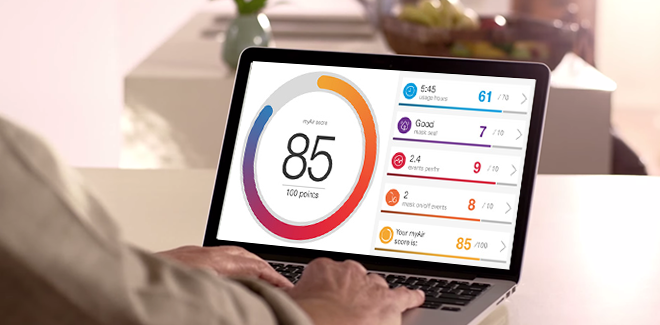No doubt you’re familiar with CPAP machine therapy and have come to know it as the ‘golden standard’ in sleep apnea treatment.
But have you ever heard your medical professional recommend a different type of ‘PAP’ therapy, or do you know what APAP machine therapy is?
That’s right: ‘APAP’. It’s no spelling mistake!
In fact, CPAP therapy is just one of three methods of ‘PAP’ therapy that can alleviate sleep apnea.
CPAP, which stands for ‘continuous positive airway pressure’ therapy, is the most common term used to describe the three types of sleep apnea therapy, even though CPAP therapy is just one of the options available for sleep apnea treatment.
There’s also APAP therapy—‘automatic positive airway pressure therapy’—or ‘VPAP’ therapy—‘variable positive airway pressure’1.
Below, we explore how APAP therapy works and how it differentiates to CPAP therapy.
What is APAP?
An Automatic Positive Airway Pressure (APAP) machine, like the ResMed AirSense AutoSet, also known as an auto-CPAP device, is just as it sounds – automatic.
This particular form of PAP therapy treats sleep apnea by delivering automatic air pressure to your mouth, nose and throat in order to help keep your airways open during sleep.
While the treatment is the same as a CPAP machine—in that the machine’s pump delivers airflow pressure to your airway via a hose that connects to a mask—the pressure of the airflow is what sets these devices apart.
APAP machines have the ability to automatically adjust the airway pressure to what you need based on changing conditions throughout the night. Over time, other natural changes such as your sleeping position affect your appropriate airflow—an APAP machine is able to take such changes into consideration and re-set your airflow pressure to accommodate.
How does APAP differentiate to CPAP?
If you have ever used CPAP before, you’ll know that usually, you will need to have an overnight sleep test to determine the airflow pressure for your device.
This fixed-pressure form of sleep apnea therapy delivers continuous airflow throughout the night. However, it will not automatically adjust throughout the night based on the breathing patterns of the user or any other fluctuating factors2. ResMed’s AirSense Elite is an example of a fixed-pressure CPAP machine.
In comparison, an APAP device will automatically change to suit your individual needs. As you enter into different stages of your sleep cycle each night, your muscles relax more – including the muscles in your airway.
The airflow automatically adjusts for each individual user thanks to algorithms3. The algorithm senses when your body is about to have an event and automatically adjusts the pressure depending on how severe the event is to keep your airways open4.
APAP is particularly useful for some users who want to tailor their device to specific conditions. For example, nasal conditions or seasonal allergies that require higher pressures during part of the night or seasonally.
There is now also a product available which includes BOTH APAP and CPAP modes - the new ResMed AirMini. This portable device not only offers this flexible option, but it’s convenient and easy to use, being the smallest portable CPAP device available on the market.
How do I know which PAP therapy to try?
How much targeted air pressure you require to keep your upper airway open each night will largely indicate whether a CPAP or APAP machine is better suited to treat your sleep apnea.
Research has found that treatment results between APAP and CPAP therapy can be similar, so whether you try APAP instead of CPAP may be determined by your personal preference or any specific clinical reasons which your doctor advises5.
.webp?width=1158&height=143&name=Combined%20logo%20-%20Ecom%20Main%20300x200%20(1).webp)




